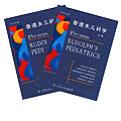鲁道夫儿科学(上、下卷)
2003-5
人民卫生出版社
鲁道夫 (Rudolph C.D.)
2688
8000000
无
The 21st edition of this comprehensive pediatric text has been thoroughly revised to provide the most current and reliable information available. Itfeatures extensive new material on: - the newborn infant - infectious diseases - parasitic diseases - ENT - teeth - oncology - orthopedics There are new chapters on emergency and critical care, contemporary diagnostic techniques, rehabilitation and chronic care, and care of children dying from chronic diseases. Extra chapters in the rheumatology section include the critical evaluation of musculoskeletal pain and pain syndromes. The dermatology section features web sites and e-mail addresses of support groups for rare and common skin conditions. There is also expanded coverage of genetics.
作者:(美国)鲁道夫 (Rudolph C.D.)
Volume 1 PREFACE ACKNOWLEDGMENTS ASSOCIATE EDITORS CONTRIBUTORS CHAPTER 1 PEDIATRIC HEALTH SUPERVISIN CHAPTER 2 THE NEWBORN INFANT CHAPTER 3 THE ADOLESCENT PATIENT CHAPTER 4 THE ACUTELY ILL INFANT AND CHILD CHAPTER 5 DEVELOPMENTAL-BEHAVIORAL PEDIATRICS CHAPTER 6 REHABILITATIN AND THE CHILD WITH DISABILITY CHAPTER 7 COMPLEX DECISIONS IN PEDIATRICS:lAW,ETHICS,AND CARE NEAR THE END OF LIFE CHAPTER 8 CONTEMPORARY DIAGNOSTIC TECHNIQUES CHAPTER 9 METABOLIC DISORDERS CHAPTER 10 GENETICS AND DYSMORPHOLOGY CHAPTER 11 ALLERGY AND IMMUNOLOGY CHAPTER 12 RHEUMATOLOGY CHAPTER 13 INFECTIOUS DISEASES CHAPTER 14 THE SKIN CHAPTER 15 THE EAR,NOSE,PHARYNX,AND LARYN CHAPTER 16 THE TEETH CHAPTER 17 GASTROENTEROLOGY AND NUTRITIONVolume 3 CHAPTER 18 THE LIVER AND BILE DUCTS CHAPTER 19 BLOOD AND BLOOD-FORMING TISSUES CHAPTER 20 ONCOLOGY CHAPTER 21 THE KIDNEYS CHAPTER 22 THE CIRCULATORY SIYSTEM CHAPTER 23 THE RESPIRATORY SYSTEM CHAPTER 24 THE ENDOCRINE SYSTEM CHAPTER 25 THJE NERVOUS SYSTEM CHAPTER 26 THE EYES CHAPTER 27 ORTHOPRDICSA PPENDICESINDEX
书评Review by Alberto Hayek, MD New York: McGraw-Hill, Medical Pub. Division; 2003. ISBN: 0838582850 2688 pages; $150.00 At 2688 pages--the weight of a healthy, 13-pound infant--this pediatrics textbook is packed with information on all aspects of children's health and disease. Using the expertise of a strong team of coeditors at Yale University, the Rudolph family continues a tradition of editorial excellence backed by more than 100 years of experience--the experience contained in 20 previous editions of this classic pediatric work. The book is divided into 27 chapters covering normal childhood development and psychosocial issues, the pathology of every organ or body system, and topics that include immunology, rheumatology, infectious diseases, cancer, and metabolic disorders. The choice of associate editors and of nearly 500 contributors is a Who's Who of the academic pediatrics world and assures that the quality of each chapter is uniformly well written, informative, and able to provide sufficient background information for the selected topic, both in content and in the amount of information provided. The editors have performed superbly in assembling this information coherently and rationally. From my own particular point of reference as a pediatric endocrinologist, I found the endocrine section first-rate. A pediatric endocrine fellow would do well to put the topic into perspective by reading this section just before obtaining certification. This strategy applies to all other pediatric subspecialists. In a book with so many contributors, duplication can be expected. After all, repetition is appropriate in this sort of reference book, which readers are likely to consult by chapter and thus may rightfully expect to be internally coherent. Such coherence may be expected, for example, in the six pages about biochemical diagnosis of inborn errors of metabolism which appear in the chapter positioned immediately before the 114-page chapter on metabolic disorders. In contrast to the book's many chapters on specialized topics, some general chapters (eg, Chapter 7, "Complex Decisions in Pediatric Care") offer a brief, insightful account of topics that rarely receive the attention necessary in busy inpatient situations, where diagnostic and procedural activities occupy most of a physician's time. Thus, this publication is indeed an outstanding pediatric textbook despite the negative aspects inherent in all textbooks: being out of date (in this case, by three years); repeating topics (a feature inherent in nearly any book with multiplicity of topics and contributors); and only minimally mentioning important topics that are almost impossible to discuss extensively within given space limitations. Rudolph's Pediatrics definitely should be part of all reference libraries in medical schools and hospitals. However, in our changing times, use of this comprehensive textbook by practicing pediatricians would probably be directly related to the user's age, which in turn is likely to reflect the user's computer skills. I suspect that for senior pediatricians trained before the advent of the computer age, Rudolph's will be the first reference used when the need for information arises. In contrast, younger physicians--whose clerkships almost certainly included use of computers linked to computer networks--may tend to turn first to the Internet for quick, convenient access to up-to-date information. -----------------------Alberto Hayek, MD, is Professor of Pediatrics at the UCSD School of Medicine and Director of the Islet Research Laboratory at the Whittier Institute for Diabetes in La Jolla, CA. With a clinical background in pediatric endocrinology, he is now spending most of his time studying potential cell replacement therapies for type I diabetes.
The 21st edition of this comprehensive pediatric text has been thoroughly revised to provide the most current and reliable information available. Itfeatures extensive new material on: - the newborn infant - infectious diseases - parasitic diseases - ENT - teeth - oncology - orthopedics There are new chapters on emergency and critical care, contemporary diagnostic techniques, rehabilitation and chronic care, and care of children dying from chronic diseases. Extra chapters in the rheumatology section include the critical evaluation of musculoskeletal pain and pain syndromes. The dermatology section features web sites and e-mail addresses of support groups for rare and common skin conditions. There is also expanded coverage of genetics.

无